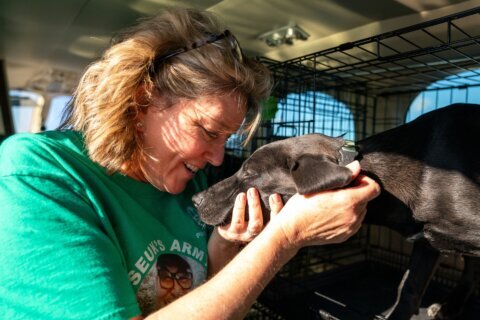When a dog runs off, it can leave an owner panicked and desperate. However, the story of a dog that was returned after six months on the run offers some hope for those still looking, and some practical advice for all dog owners.
Something spooked 3-year-old Autumn, a Finnish Spitz mix, while out for a walk in December. In a flash, the little dog was gone, trailing her leash behind her along Virginia’s streets.
Jennifer Toussaint, Chief of Animal Control for the Animal Welfare League of Arlington, remembers first hearing about the case that would demand all her animal handling and corralling skills.
“The call came in Dec. 28, 2023,” she told WTOP.
Reports of sightings followed immediately after Autumn was first reported missing, including the kind that no dog owner or dog lover wants to hear.
Toussaint said one caller reported seeing a dog matching Autumn’s description, “dragging a leash, heading onto the direction of one of the highways here in Arlington.”
It’s the kind of call Toussaint calls “terrifying.”
Then the reported sightings stopped cold.
“We went all the way through January with Autumn being spotted absolutely nowhere in Arlington’s community,” Toussaint said.
Any pet owner might despair at that point, but not Toussaint and her team. Though there was some frustration.
“Here in Arlington, we traditionally recover animals fairly quickly. … So, the team was just baffled.”
Autumn was going to be a challenging case for another reason, Toussaint said. She had only recently been adopted and was just getting to know her new owner. Autumn had been raised on a farm in Korea where dogs are sold for meat.
“And so everything was terrifying to her,” Toussaint said, making capture very tricky.
Then in February, they got a break: a reported sighting of a dog that appeared to be Autumn, now dragging just a scrap of her leash from her collar. She was darting from the National Cemetery in Arlington to the grounds of the Fort Meyer Military installation.
The next step was to “centralize” Autumn — a process aimed at getting a dog to stop running and, instead, stick to a smaller area, where the likelihood of a recovery increases.
The team from AWLA spent months working to gain Autumn’s trust through food that appealed to her, but found she was quick to sense any attempt to trap or capture her.
So Toussaint and her team settled in, making only the tiniest adjustments to the traps they were using, hoping that Autumn would eventually enter one.
They even used the skills of a volunteer who “was able to create a laser tripping mechanism,” which would automatically close as soon as Autumn entered the trap. And it worked.
“Slow and steady sometimes does win the race,” Toussaint said.
If your dog takes off: What to do
During the Fourth of July holiday weekend, dogs that are normally easygoing may be spooked by the noise and take off. And while ThunderShirts, dance parties and anxiety meds can help, they can’t always keep a beloved pet from running away.
Toussaint said, when all else fails, there are some ways to boost the likelihood that an owner’s beloved pet can be recovered quickly and safely.
“Remember that time is important,” Toussaint said. “Our pets can move very far in a short period of time.”
Don’t be surprised if, when you do spot them, they turn away and run off.
Toussaint said when pets run away after a scare, they aren’t really themselves. Animals quickly become overwhelmed and disoriented by their surroundings, with cars honking at them, or strangers trying to be helpful and chasing after them.
First, be sure that your dog has identification of some sort and is microchipped. That will increase the likelihood of a quick return. Toussaint said, with that information, you can begin calling your local shelter immediately.
“And if by hour two or three, you’ve not located your pet, start reaching out further,” she said.
Toussaint said so many people in the D.C. area commute long distances or regularly travel from one jurisdiction to another, so it’s important to contact area shelters beyond your neighborhood.
“We’ve had pets from Arlington end up at the D.C. animal shelter,” she said.
The animal control chief also said to make use of all those photos of your pet on your phone, adding that clear, full body images are helpful.
“Get on your local Nextdoor, get on your community Facebook page, post the picture of your pet lovingly sleeping on your couch or playing with your children in the backyard and say, ‘Help, my pet is missing!'”
And when making fliers to post on social media or in your neighborhood, include one, clear message — the word “reward.”
“You don’t have to list what the reward is,” simply including the word in bold letters at the top “increases its visibility by 70%,” said Toussaint.
When those types of fliers are posted in neighborhoods, she said people tend to stop and often take a photo of it just in case they spot the missing animal.
And finally, Toussaint said, don’t lose hope.
“Diligence is really important. Continue to post, continue to get the message out to the region that your pet is missing. You never know,” she told WTOP.
Toussaint hopes that every missing pet is reunited, just like Autumn was reunited with her owners. And yes, she said, there were tears — lots and lots of happy tears.
Get breaking news and daily headlines delivered to your email inbox by signing up here.
© 2024 WTOP. All Rights Reserved. This website is not intended for users located within the European Economic Area.








